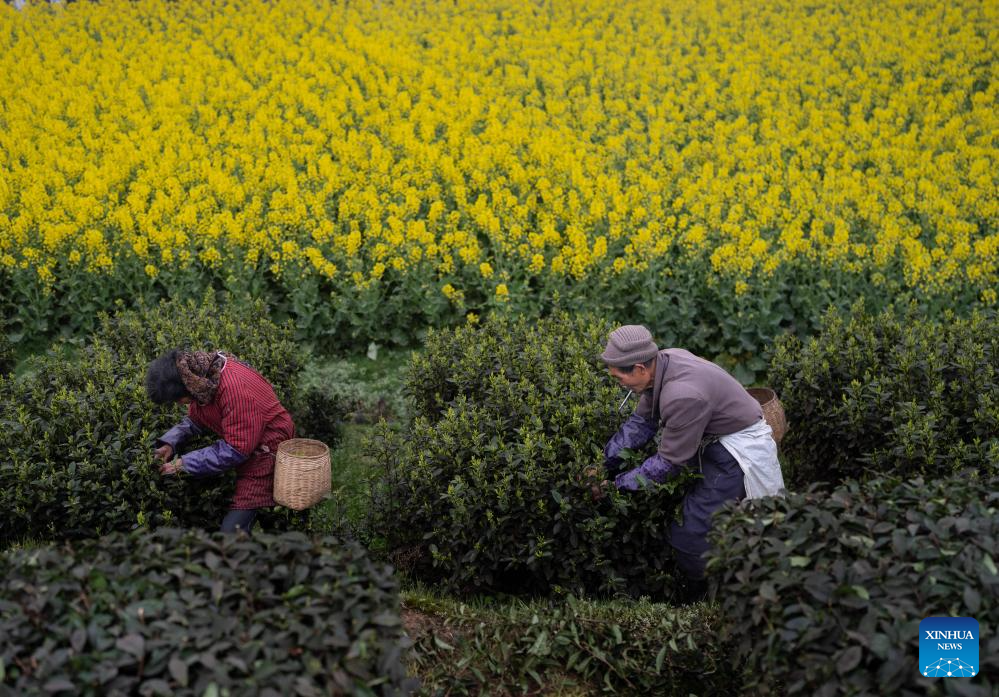


Villagers pick fresh tea leaves at Meiling Village of Naxi District, Luzhou City, southwest China's Sichuan Province, March 10, 2024. In recent years, Naxi District has vigorously developed early spring tea planting and promoted the development of tea tourism.
With its tea planting area totaling 315,000 mu (21,000 hectares), Naxi District can produce 23,000 tonnes of tea leaves every year, benefiting more than 5,600 households and cultivating over 100 tea processing enterprises. (Xinhua/Jiang Hongjing)

A villager picks fresh tea leaves at Meiling Village of Naxi District, Luzhou City, southwest China's Sichuan Province, March 10, 2024. In recent years, Naxi District has vigorously developed early spring tea planting and promoted the development of tea tourism.
With its tea planting area totaling 315,000 mu (21,000 hectares), Naxi District can produce 23,000 tonnes of tea leaves every year, benefiting more than 5,600 households and cultivating over 100 tea processing enterprises. (Xinhua/Jiang Hongjing)

An aerial drone photo taken on March 10, 2024 shows tourists visiting a tea-themed park at Meiling Village of Naxi District, Luzhou City, southwest China's Sichuan Province. In recent years, Naxi District has vigorously developed early spring tea planting and promoted the development of tea tourism.
With its tea planting area totaling 315,000 mu (21,000 hectares), Naxi District can produce 23,000 tonnes of tea leaves every year, benefiting more than 5,600 households and cultivating over 100 tea processing enterprises. (Xinhua/Jiang Hongjing)

Tourists wearing traditional attire, known as Hanfu, pick tea leaves at Meiling Village of Naxi District, Luzhou City, southwest China's Sichuan Province, March 10, 2024. In recent years, Naxi District has vigorously developed early spring tea planting and promoted the development of tea tourism.
With its tea planting area totaling 315,000 mu (21,000 hectares), Naxi District can produce 23,000 tonnes of tea leaves every year, benefiting more than 5,600 households and cultivating over 100 tea processing enterprises. (Xinhua/Jiang Hongjing)

Tourists pick tea leaves at a tea-themed park in Meiling Village of Naxi District, Luzhou City, southwest China's Sichuan Province, March 10, 2024. In recent years, Naxi District has vigorously developed early spring tea planting and promoted the development of tea tourism.
With its tea planting area totaling 315,000 mu (21,000 hectares), Naxi District can produce 23,000 tonnes of tea leaves every year, benefiting more than 5,600 households and cultivating over 100 tea processing enterprises. (Xinhua/Jiang Hongjing)

A drone photo taken on March 10, 2024 shows villagers picking fresh tea leaves at Meiling Village of Naxi District, Luzhou City, southwest China's Sichuan Province. In recent years, Naxi District has vigorously developed early spring tea planting and promoted the development of tea tourism.
With its tea planting area totaling 315,000 mu (21,000 hectares), Naxi District can produce 23,000 tonnes of tea leaves every year, benefiting more than 5,600 households and cultivating over 100 tea processing enterprises. (Xinhua/Jiang Hongjing)

A child plays at a tea garden in Dehong Village of Naxi District, Luzhou City, southwest China's Sichuan Province, March 10, 2024. In recent years, Naxi District has vigorously developed early spring tea planting and promoted the development of tea tourism.
With its tea planting area totaling 315,000 mu (21,000 hectares), Naxi District can produce 23,000 tonnes of tea leaves every year, benefiting more than 5,600 households and cultivating over 100 tea processing enterprises. (Xinhua/Jiang Hongjing)
点击右上角![]() 微信好友
微信好友
 朋友圈
朋友圈

请使用浏览器分享功能进行分享
